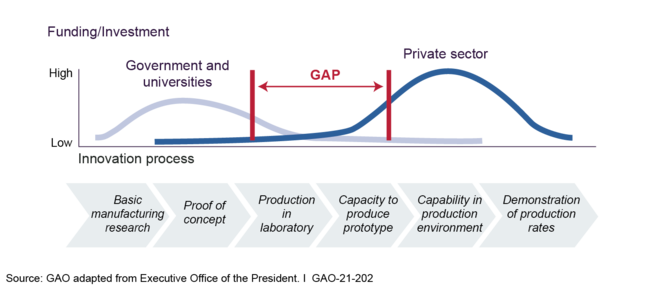Department of Energy: Improved Performance Planning Could Strengthen Technology Transfer
Fast Facts
A Department of Energy national lab developed a battery that now powers some hybrid and electric cars. But how do new energy technologies get from the lab to the market?
Transferring technologies from the DOE to private companies isn't always easy. Barriers such as the "valley of death"—a gap between the end of public funding and the start of private funding—can stop a transfer.
The DOE has taken steps to address barriers, such as providing training on transferring technologies. But, it could better measure the progress of its technology transfer efforts.
We recommended developing performance goals and measures for technology transfers.

Highlights
What GAO Found
The Department of Energy (DOE) and its national labs have taken several steps to address potential barriers to technology transfer—the process of providing DOE technologies, knowledge, or expertise to other entities. GAO characterized these barriers as (1) gaps in funding, (2) legal and administrative barriers, and (3) lack of alignment between DOE research and industry needs. For example, the “valley of death” is a gap between the end of public funding and start of private-sector funding. DOE partly addresses this gap with its Technology Commercialization Fund, which provides grants of $100,000 to $1.5 million to DOE researchers to advance promising technologies with private-sector partners. Further, DOE's Energy I-Corps program trains researchers to commercialize new technologies and to identify industry needs and potential customers. However, DOE has not assessed how many and which types of researchers would benefit from such training. Without doing so, DOE will not have the information needed to ensure its training resources target the researchers who would benefit most.
Illustration of Funding Gap for Commercializing New Technologies

DOE plans and tracks the performance of its technology transfer activities by setting strategic goals and objectives and annually collecting department-wide technology transfer measures, such as the number of patented inventions and licenses. However, the department does not have objective and measurable performance goals to assess progress toward the broader strategic goals and objectives it developed. For example, without a performance goal for the number of DOE researchers involved in technology transfer activities and a measure of such involvement, DOE cannot assess the extent to which it has met its objective to encourage national laboratory personnel to pursue technology transfer activities. Internal control standards for government agencies call for management to define objectives in measurable terms, either qualitative or quantitative, so that performance toward those objectives can be assessed. Moreover, DOE has not aligned the 79 existing measures that it collects with its goals and objectives, nor has it prioritized them. Some lab stakeholders said that collecting and reporting these measures is burdensome. Prior GAO work has found that having a large number of performance measures may risk creating a confusing excess of data that will obscure rather than clarify performance issues.
Why GAO Did This Study
Researchers at DOE and its 17 national labs regularly make contributions to new energy technologies, such as more efficient batteries for electric vehicles. Technology transfer officials at the labs help these researchers license intellectual property and partner with private-sector companies to bring these technologies to market. However, several recent reports have highlighted barriers and inconsistencies in technology transfer at DOE, including a 2015 commission report that found barriers related to the costs of collaboration and low maturity level of many DOE technologies.
This report examines (1) steps DOE has taken to address barriers to technology transfer and (2) the extent to which DOE plans and tracks the performance of its technology transfer and commercialization activities. GAO analyzed DOE documents on technology transfer and spoke with officials at DOE and seven national labs, as well as with representatives of universities and private-sector companies. GAO selected labs across a range of DOE activities and based on their technology transfer activities.
Recommendations
GAO recommends that DOE assess researchers' needs for commercialization training and develop objective, quantifiable, and measurable performance goals and a limited number of related performance measures for its technology transfer efforts. DOE concurred with the recommendations.
Recommendations for Executive Action
| Agency Affected | Recommendation | Status |
|---|---|---|
| Department of Energy | The Director of OTT should assess whether researchers at the national labs, sites, and plants have the skills necessary to effectively identify and collaborate with technology transfer partners, and should provide training to address any skill gaps. (Recommendation 1) |
As of August 2024, the Department has commissioned an external study of the entrepreneurship and commercialization culture of DOE national labs that assessed survey results from approximately 2,000 employees across six DOE laboratories. The report identified five areas in which the participating labs scored lower than benchmarks from high tech private sector firms, including employee skills and creativity, and recommended further training in innovation and communication, among other things. To strengthen the Department's training, in fiscal years 2022-2024, the Office of Technology Transfer (OTT) created Energy I-Corps Topic 1 awards to increase tech transfer capabilities and increase participation in Energy I-Corps training cohorts. All 17 national labs have completed topic 1 projects, providing additional training to participating employees. These actions will help ensure that more researchers at the national labs are developing skills in technology transfer.
|
| Department of Energy | The Director of OTT should develop objective, quantifiable, and measurable performance goals as appropriate, and a limited number of related performance measures or milestones, to assess progress toward the objectives in its technology transfer execution plan and signal priorities. (Recommendation 2) |
In July 2024, the Department's Office of Technology Transfer (OTT) released the Technology Transfer Execution Plan for Fiscal Years 2021 to 2025. The plan includes strategic goals and objectives and metrics for each objective.
|
